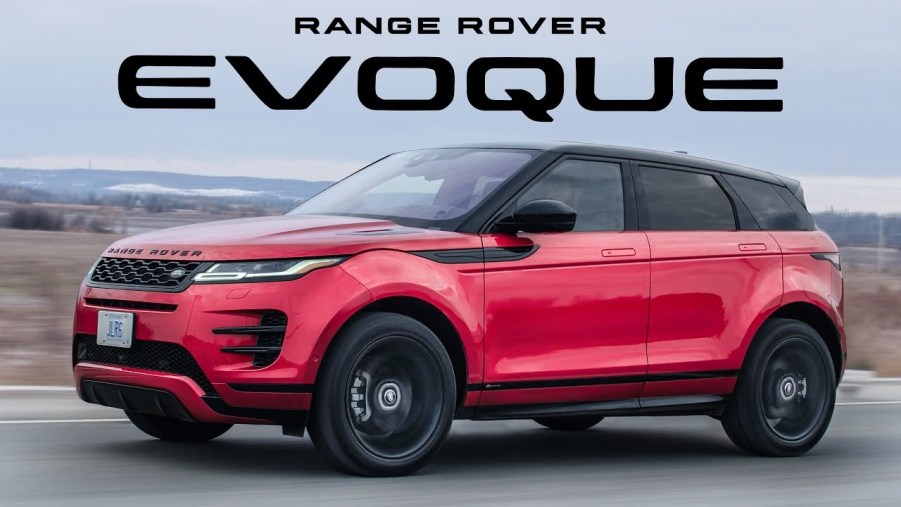
Can the Range Rover Evoque Actually Go Off-Road?
Land Rover’s Range Rover may be expensive and have questionable reliability, but its reputation is based on honest ability. It’s not exactly a G-Wagen, but the Range Rover can, in fact, rove over a range of terrains. Jaguar Land Rover’s recent purchase of off-road tuner Bowler will no doubt further increase the SUV’s capability. But the Range Rover lineup doesn’t just include mild hybrids and sporty haulers—there’s also the more-affordable Evoque. More a crossover than SUV, the Range Rover Evoque may be stylish, but is it also capable of going off-road?
How does the Range Rover Evoque handle off-roading?
As Top Gear reported when the first-gen model debuted, the Range Rover Evoque doesn’t have all of the full-size Range Rover’s off-road features. The Evoque doesn’t have a locking differential, for example, or twin-speed transfer case. However, the Evoque can, in fact, venture off-pavement. Part of the reason it won Motor Trend’s 2012 SUV of the Year Award was due to its off-road prowess, even on all-season street tires.
In addition to the standard all-wheel drive, the Evoque comes with hill-descent control and JLR’s Terrain Response 2TM system. This works with the SUV’s engine, throttle, transmission, AWD system, and adjustable suspension to alter how the Evoque performs based on the terrain. Motor Trend reports that the latest Evoque can wade into water almost 2’ high. Optional ultrasonic sensors warn the driver if the water’s too deep to ford.

The SUV’s camera system also helps with off-roading. Front-mounted cameras, pointing both ahead and downward, feed a 180° view of the ground, letting the Evoque’s driver pick their way around obstacles, like rocks or curbs.
The Range Rover Evoque also has 8.3” of ground clearance: not as much as a Wrangler, but it matches the Suzuki Jimny’s. Although, the Jimny has better break-over, departure, and approach angles.
So, do all these features translate into an effective off-roader? While you wouldn’t take the Range Rover Evoque on the Rubicon Trail, the SUV has more than enough capability for most consumers. Top Gear’s James May crossed several Death Valley dunes in a previous-gen model. Carwow’s Mat Watson found the new Evoque performed excellently in his off-road tests, although he noted the top-of-the-line R Dynamic Evoque’s different bumper design means its departure and approach angles are worse.
How does the Range Rover Evoque perform on pavement?
As expected of a Range Rover, the Evoque comes with quite a few luxury features.

While leather is standard, Car and Driver reports, the textured-cloth upholstery is also worth a look. Dual-zone automatic climate control is standard, as are power-adjustable seats and a 10” touchscreen. Heated and cooled front seats are an option, and upper-trim Evoques also get a secondary 10” screen. Also, the Evoque’s cameras aren’t just for off-roading. The rearview mirror can display the rear camera feed, meaning you can transport tall objects without worrying about vision obstruction.
The Evoque also offers a number of other useful features. Standard safety features include automatic emergency braking, as well as lane-departure warning and lane-keeping assist. Radar-adaptive cruise control, however, is extra. The Evoque can also tow up to 3306 pounds, and there’s an option that lets Evoques with the secondary touchscreen use it to back the trailer up more easily.

Compared to the previous-gen Evoque, the current model has a much more comfortable ride, according to Car and Driver. MT also noted the interior was quieter, with less engine noise and vibration coming through. And while the interior is appreciably luxurious, the exterior is still the Evoque’s biggest selling point. Motor Trend, Car and Driver, Carfection and The Straight Pipes all appreciated the SUV’s sharp style.
However, the Range Rover Evoque isn’t perfect.
Where it falls flat
While the Evoque’s design is stylish, it also causes some day-to-day practicality compromises, as does the SUV’s rather small size. The rear seats are cramped, even compared to other subcompact SUVs/crossovers.
Although its 2.0-liter turbocharged 4-cylinder does make good power—246 hp in the P250, 296 hp in the mild-hybrid P300—the 9-speed automatic transmission is slow to shift. The Straight Pipes experienced significant lag, both while at speed and from a standstill.

The infotainment system is also laggy. Car and Driver placed BMW’s X2 over the Range Rover Evoque in part due to the touchscreen’s glitches and slow responses. The rear camera in the Evoque tested by Car and Driver also froze up and started stuttering right when the proximity lines started displaying. Precisely when you don’t want the camera to fail.
While Truck Trend didn’t experience any ‘traditional’ Land Rover electrical issues during the Evoque’s long-term stay with the publication, there were some other minor issues. Chiefly, the premature wearing and stretching of the leather seats. Along with loose door bolts and broken cargo cover connectors, it’s not the most positive indicator of quality. In fact, Consumer Reports gave the Evoque its lowest reliability rating.
Is the Evoque worth considering?

A base Evoque S starts at $42,540 in P250 trim. To get the P300 engine, buyers need to step up to the R-Dynamic Evoque, starting at $46,600. Considering some Range Rovers can cost up to $200k, that’s a substantial bargain. If you’re after a good-looking luxury small SUV/crossover that doesn’t embarrass itself when the road gets rocky, the Range Rover Evoque has a lot to offer.

However, there are other luxury compact SUVs that offer the same capability with more reliability. The Porsche Macan received an above-average reliability score from Consumer Reports and is actually a CR recommendation. With a starting price just over $51k, the Macan isn’t substantially more expensive than the Evoque. And just like its big brother, the Cayenne, the Macan can properly off-road, as Autoweek discovered.
Follow more updates from MotorBiscuit on our Facebook page.


